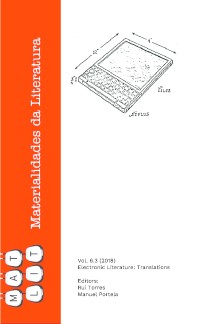Please use this identifier to cite or link to this item:
https://hdl.handle.net/10316.2/44377| Title: | The interlocutor in print and digital fiction: dialogicity, agency, (de-)conventionalization | Authors: | Ensslin, Astrid | Keywords: | digital fiction;unnatural narrative;anti-mimetic;interlocutor;dialogicity;ficção digital;narrativa não-natural;antimimético;interlocutor;dialogicidade | Issue Date: | 2018 | Publisher: | Centro de Literatura Portuguesa Imprensa da Universidade de Coimbra |
Abstract: | A ficção digital tipicamente coloca o leitor/jogador num diálogo cibernético com várias funções narrativas, tais como personagens, vozes narrativas ou sugestões que emanam do ambiente narrativo. Os leitores acionam as suas respostas verbalmente, por meio de entrada digitada no teclado, ou por meio de vários tipos de interações físicas com a interface (clique do rato, movimentos do controlador, toque). O sentido de agência evocado através dessas interações dialógicas encontra-se totalmente convencionado como parte da narratividade digital. No entanto, existem exemplos de dialogismo encenado na ficção digital que merecem investigação mais aprofundada sob as designações latas de antimimetismo e não-naturalidade intrínseca (Richardson, 2016), como quando os leitores se tornam narratários pré-definidos sem, no entanto, poderem ter agência sobre a narrativa (canônica) como um todo (Frankenstein de Dave Mor-ris), ou quando ouvem ou leem uma “protean,” “disembodied questioning voice” (Richardson, 2006: 79) que oscila entre o feedback do sistema, o monólogo interior da personagem e a interação sobrenatural (WALLPAPER da Dreaming Methods). Examino vários exemplos intrinsecamente não naturais de interlocutores medialmente específicos em ficção impressa e digital e avalio até que ponto os interlocutores não convencionais na ficção digital podem ter efeitos antimiméticos ou de desfamiliarização. Digital fiction typically puts the reader/player in a cybernetic dialogue with various narrative functions, such as characters, narrative voices, or prompts emanating from the storytelling environment. Readers enact their responses either verbally, through typed keyboard input, or haptically, through various types of physical interactions with the interface (mouseclick; controller moves; touch). The sense of agency evoked through these dialogic interactions has been fully conventionalized as part of digital narrativity. Yet there are instances of enacted dialogicity in digital fiction that merit more in-depth investigation under the broad labels of anti-mimeticism and intrinsic unnaturalness (Richardson, 2016), such as when readers enact pre-scripted narratees without, however, being able to take agency over the (canonical) narrative as a whole (Dave Morris’s Frankenstein), or when they hear or read a “protean,” “disembodied questioning voice” (Richardson, 2006: 79) that oscillates between system feedback, interior character monologue and supernatural interaction (Dreaming Methods’ WALLPAPER). I shall examine various intrinsically unnatural examples of the media-specific interlocutor in print and digital fiction and evaluate the extent to which unconventional interlocutors in digital fiction may have anti-mimetic, or defamiliarizing effects. |
URI: | https://hdl.handle.net/10316.2/44377 | ISSN: | 2182-8830 | DOI: | 10.14195/2182-8830_6-3_2 | Rights: | open access |
| Appears in Collections: | Matlit |
Files in This Item:
| File | Description | Size | Format | |
|---|---|---|---|---|
| the_interlocutor_in_print_and_digital_ficition.pdf | 786.97 kB | Adobe PDF |  |
Items in DSpace are protected by copyright, with all rights reserved, unless otherwise indicated.
